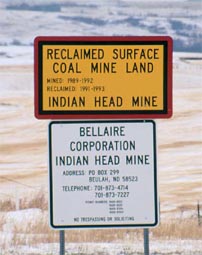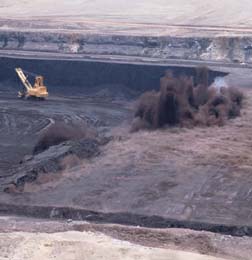
Surface Mining Control and Reclamation Act of 1977
Encyclopedia

Coal mining
The goal of coal mining is to obtain coal from the ground. Coal is valued for its energy content, and since the 1880s has been widely used to generate electricity. Steel and cement industries use coal as a fuel for extraction of iron from iron ore and for cement production. In the United States,...
in the United States
United States
The United States of America is a federal constitutional republic comprising fifty states and a federal district...
.
SMCRA created two programs: one for regulating active coal mines and a second for reclaiming abandoned mine lands. SMCRA also created the Office of Surface Mining
Office of Surface Mining
The Office of Surface Mining Reclamation and Enforcement is a branch of the United States Department of the Interior...
, an agency within the Department of the Interior
United States Department of the Interior
The United States Department of the Interior is the United States federal executive department of the U.S. government responsible for the management and conservation of most federal land and natural resources, and the administration of programs relating to Native Americans, Alaska Natives, Native...
, to promulgate regulations, to fund state regulatory and reclamation efforts, and to ensure consistency among state regulatory programs.
Passage
SMCRA grew out of a concern about the environmental effects of strip miningSurface mining
Surface mining , is a type of mining in which soil and rock overlying the mineral deposit are removed...
. Coal had been mined in the United States since the 1740s, but surface mining did not become widespread until the 1930s. At the end of that decade, states began to enact the first laws regulating the coal mining industry: West Virginia
West Virginia
West Virginia is a state in the Appalachian and Southeastern regions of the United States, bordered by Virginia to the southeast, Kentucky to the southwest, Ohio to the northwest, Pennsylvania to the northeast and Maryland to the east...
in 1939, Indiana
Indiana
Indiana is a US state, admitted to the United States as the 19th on December 11, 1816. It is located in the Midwestern United States and Great Lakes Region. With 6,483,802 residents, the state is ranked 15th in population and 16th in population density. Indiana is ranked 38th in land area and is...
in 1941, Illinois
Illinois
Illinois is the fifth-most populous state of the United States of America, and is often noted for being a microcosm of the entire country. With Chicago in the northeast, small industrial cities and great agricultural productivity in central and northern Illinois, and natural resources like coal,...
in 1943, and Pennsylvania
Pennsylvania
The Commonwealth of Pennsylvania is a U.S. state that is located in the Northeastern and Mid-Atlantic regions of the United States. The state borders Delaware and Maryland to the south, West Virginia to the southwest, Ohio to the west, New York and Ontario, Canada, to the north, and New Jersey to...
in 1945. Despite those laws, the great demand for coal during World War II
World War II
World War II, or the Second World War , was a global conflict lasting from 1939 to 1945, involving most of the world's nations—including all of the great powers—eventually forming two opposing military alliances: the Allies and the Axis...
led to coal being mined with little regard for environmental consequences. After the war, states continued to enact and expand regulatory programs, some of which required mining permits or the posting of bonds to ensure that the land could be reclaimed after mining was complete. But these state laws were largely unsuccessful at stemming the environmental impacts of surface mining. One problem was that the law varied from state to state, enabling mining operations to relocate to states where regulations were less strict. Meanwhile, surface mining became increasingly common: in 1963 just 33 percent of American coal came from surface mines; by 1973 that figure reached 60 percent.
In 1974 and 1975 Congress sent mining regulation bills to President Gerald Ford
Gerald Ford
Gerald Rudolph "Jerry" Ford, Jr. was the 38th President of the United States, serving from 1974 to 1977, and the 40th Vice President of the United States serving from 1973 to 1974...
, but he vetoed them out of concern that they would harm the coal industry, increase inflation, and restrict the energy supply. As Jimmy Carter
Jimmy Carter
James Earl "Jimmy" Carter, Jr. is an American politician who served as the 39th President of the United States and was the recipient of the 2002 Nobel Peace Prize, the only U.S. President to have received the Prize after leaving office...
campaigned in Appalachia in 1976, he promised to sign those bills. Congress sent him a bill that was even more stringent than those vetoed by Ford, and President Carter signed it into law on August 3, 1977.
Regulatory program
The regulation of active mines under SMCRA has thirteen major components:
- Standards of Performance. SMCRA and its implementing regulations set environmental standards that mines must follow while operating, and achieve when reclaiming mined land.
- Permitting. SMCRA requires that companies obtain permits before conducting surface mining. Permit applications must describe what the premining environmental conditions and land use are, what the proposed mining and reclamation will be, how the mine will meet the SMCRA performance standards, and how the land will be used after reclamation is complete. This information is intended to help the government determine whether to allow the mine and set requirements in the permit that will protect the environment.
- Bonding. SMCRA requires that mining companies post a bond sufficient to cover the cost of reclaiming the site. This is meant to ensure that the mining site will be reclaimed even if the company goes out of business or fails to clean up the land for some other reason. The bond is not released until the mining site has been fully reclaimed and the government has (after five years in the East and ten years in the West) found the that the reclamation was successful.
- Inspection and Enforcement. SMCRA gives government regulators the authority to inspect mining operations, and to punish companies that violate SMCRA or an equivalent state statute. Inspectors can issue "notices of violation," which require operators to correct problems within a certain amount of time; levy fines; or order that mining cease.
- Land Restrictions. SMCRA prohibits surface mining altogether on certain lands, such as in National Parks and wilderness areas. It also allows citizens to challenge proposed surface mining operations on the ground that they will cause too much environmental harm.
Reclamation program
SMCRA created an Abandoned Mine Land (AML) fund to pay for the cleanup of mine lands abandoned before the passage of the statute in 1977. The law was amended in 1990 to allow funds to be spent on the reclamation of mines abandoned after 1977. The fund is financed by a tax of 31.5 cents per ton for surface mined coal, 15 cents per ton for coal mined underground, and 10 cents per ton for ligniteLignite
Lignite, often referred to as brown coal, or Rosebud coal by Northern Pacific Railroad,is a soft brown fuel with characteristics that put it somewhere between coal and peat...
. 80% of AML fees are distributed to states with an approved reclamation program (see below) to fund reclamation activities. The remaining 20% are used by OSM to respond to emergencies such as landslides, land subsidence, and fires, and to carry out high priority cleanups in states without approved programs. States with approved programs can also use AML funds to set up programs to insure homeowners against land subsidence caused by underground mining.
State/federal relationship
Like most environmental statutes passed in the 1960s and 1970s, SMCRA uses a cooperative federalismCooperative Federalism
Cooperative federalism is a concept of federalism in which national, state, and local governments interact cooperatively and collectively to solve common problems, rather than making policies separately but more or less equally or clashing over a policy in a system dominated by the national...
approach under which states are expected to take the lead in regulation while the federal government oversees their efforts. Under SMCRA, the federal government can approve a program, which gives the state the authority to regulate mining operations, if the state demonstrates that it has a law that is at least as strict as SMCRA, and that they have a regulatory agency with the wherewithal to operate the program. Currently, most coal-mining states have approved programs. Those states issue their own permits, inspect their mines, and take enforcement action themselves when necessary. In the two states without approved programs (Tennessee
Tennessee
Tennessee is a U.S. state located in the Southeastern United States. It has a population of 6,346,105, making it the nation's 17th-largest state by population, and covers , making it the 36th-largest by total land area...
and Washington) and on Indian Reservations, the Office of Surface Mining performs those functions. The federal government is required to regulate surface coal mining on federal lands (which include 60 percent of the coal reserves in the West), but can enter into cooperative agreements with states with approved programs.
External links
- Text of SMCRA, 30 U.S.C. §§ 1234-1328.
- SMCRA regulations, 30 CFR Part 700 et seq.
- Office of Surface Mining homepage

